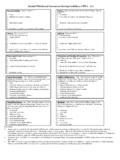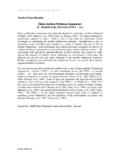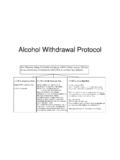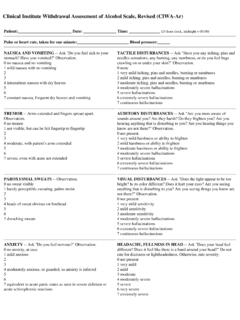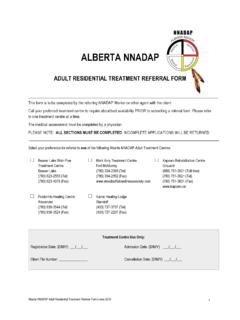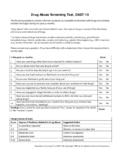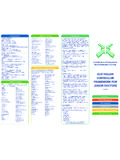Transcription of The Alcohol Use Disorders Identification Test, …
1 The Alcohol Use Disorders Identification Test, adapted for Use in the United States: A Guide for Primary Care PractitionersUSAUDITUSAUDITThe Alcohol Use Disorders Identification Test, adapted for Use in the United States: A Guide for Primary Care PractitionersThomas F. BaborJohn C. Higgins-BiddleKatherine RobainaAcknowledgmentsThe preparation of this document was coordinated by Thomas Babor with technical assistance from John Higgins-Biddle and Katherine Robaina. The views, opinions, and content of this guide are those of the authors and do not necessarily reflect the views, opinions, or policies of the Substance Abuse and Mental Health Services Administration (SAMHSA), Center for Substance Abuse Treatment (CSAT) or the World Health Organization (WHO). This guide was funded by SAMHSA/CSAT and prepared by JBS International, Inc., under Contract No. HHSS283201200002I/HHSS28342003T. Partial support for the revision and dissemination of this manual was also provided by the National Institute on Alcohol Abuse and Alcoholism (Grant # 5P60AA003510-36).
2 This manual is an adaptation of an earlier publication (Babor, Higgins-Biddle, Saunders, & Monteiro, 2001) published by ..1 The purpose of this .0 The USAUDIT ..2 What is the USAUDIT? ..2 Why screen for Alcohol ? ..3 What are the health consequences of hazardous and harmful Alcohol use?..3Do patients respond truthfully to questions about their drinking? ..6 How do practitioners successfully conduct the USAUDIT screening? ..72 .0 Using the USAUDIT ..8 How to administer the USAUDIT most efficiently ..8 How to develop a screening plan ..10 How to introduce the USAUDIT ..103 .0 Scoring, interpreting, and using the USAUDIT ..11 Conducting the intervention for at-risk treatment for harmful intervention facilitating referral to evaluation and treatment ..15 Detoxification ..15 References ..16 Appendix A. The USAUDIT B. USAUDIT-C C. A Guide to Low-Risk Table 1. Diagnostic Terms and Drinking Limit Descriptions ..2 Table 2. Domains and Item Content of the USAUDIT.
3 9 Table 3. Guidance for Interpreting the 1. Health Consequences of Hazardous and Harmful Alcohol 2. Patient Comfort With 3. The Drinkers World Health Organization (WHO) developed the Alcohol Use Disorders Identification Test (AUDIT) in 1989 as a simple method of screening for hazardous and harmful drinking. Since its introduction, the AUDIT has become the most widely used Alcohol screening test in the world. The AUDIT now has more than a quarter century s worth of validation studies and practical applications in a wide variety of medical and research settings worldwide (Allen, Litten, Fertig, & Babor, 1997; Babor & Robaina, 2016). The AUDIT was recently adapted for use in the United States (Centers for Disease Control and Prevention [CDC], 2014).1 The purpose of the USAUDIT is to identify individuals with risky patterns of Alcohol consumption, as defined by the standard drink (14 grams) and recommended drinking limits (National Institute on Alcohol Abuse and Alcoholism [NIAAA], 2007), and those who may have an Alcohol use disorder (AUD), according to the International Classification of Mental and Behavioral Diseases Tenth Revision (ICD-10; WHO, 1993) and the Diagnostic and Statistical Manual of Mental Disorders Fifth Edition(DSM-5; American Psychiatric Association [APA], 2013).
4 The purpose of this guideIncluded in this guide are instructions for the clinical application of the USAUDIT, a new adaptation of the instrument designed to meet NIAAA s recommended low-risk drinking levels as well as the severity levels recommended by WHO. The guide focuses on primary care settings. Practitioners in other medical and human service settings such as obstetrics-gynecology clinics and specialty clinics for HIV/AIDS and sexually transmitted diseases will find it useful as well. This guide has three main parts. Section 1 describes the USAUDIT, Section 2 explains how to use the test, and Section 3 explains how to score and interpret the test results. In addition to these sections, a reference list is provided along with appendices. The appendices contain the USAUDIT Questionnaire (Appendix A), USAUDIT-C Questionnaire (Appendix B), and a handout on low-risk drinking (Appendix C).Target audienceThis guide is for healthcare personnel working in primary healthcare settings who routinely come into contact with people who may use Alcohol in a risky or harmful way.
5 This audience includes physicians, general practitioners, community health workers, behavioral health workers, health educators, nurses, social workers, psychologists, psychiatrists, obstetricians, and midwives. In addition, the target audience includes program managers, health service administrators, and support staff responsible for the incorporation of screening and early intervention procedures into the operations of routine primary health care. 1 For assistance in the planning and implementation of Alcohol screening and brief intervention, refer to the SAMHSA SBIRT Website or to CDC s Planning and Implementing Screening & Brief Intervention for Risky Alcohol Use: A Step-by-Step Guide for Primary Care Practices. Atlanta, Georgia: The USAUDITWhat is the USAUDIT?The USAUDIT is a brief screening questionnaire used in medical and social service settings to identify individuals using alcoholic beverages in a hazardous or harmful way.
6 It is used to conduct routine as well as opportunistic screening. The USAUDIT is based on the same 10 questions developed by WHO for the international version of the AUDIT (Saunders, Aasland, Babor, de la Fuente, & Grant, 1993). The first three questions of the AUDIT have been adjusted for the standard drink size (14 grams versus 10 grams of Alcohol used in the international version) and drinking limits, as recommended in the AUDIT manual developed by WHO (Babor et al., 2001). The adjustments in the USAUDIT further include expanding the number of response alternatives in questions 1 3 (USAUDIT-C) and modifying the wording of question 3. These modifications improve precision in measuring the frequency and quantity of drinking and enable health practitioners to intervene according to the NIAAA low-risk drinking limits for men and women. Table 1 describes the NIAAA limits as well as other relevant terms used in this manual. Table 1. Diagnostic Terms and Drinking Limit DescriptionsTermDescriptionLow Risk Alcohol UseNIAAA defines low-risk Alcohol use for men up to age 65 as no more than 4 drinks on any single day and no more than 14 drinks per week.
7 For women and men ages 66 and older, low-risk Alcohol use is no more than 3 drinks on any single day and no more than 7 drinks per week. Research shows that few people who drink within these limits have Alcohol -related health conditions. Some people should not drink at all ( , those taking medications that interact with Alcohol , patients with a medical condition that can be made worse by drinking, those under the legal drinking age, anyone planning to drive a vehicle or operate machinery, and women who are pregnant or trying to become pregnant).Hazardous DrinkingHazardous Alcohol use is a pattern of drinking that increases the risk of future Alcohol -related problems, although it may not yet be causing such Alcohol UseHarmful Alcohol use is a pattern of drinking that is damaging to the physical or mental health of the user (WHO, 1993).Binge DrinkingBinge drinking is a pattern of Alcohol use that on a single occasion brings blood Alcohol concentration (BAC) levels to g/dL.
8 This typically occurs after 4 drinks for women and about 5 drinks for men, if consumed in approximately 2 hours (NIAAA, 2007).Heavy DrinkingEngaging in binge drinking 5 or more days in the past 30 days is referred to as heavy drinking (Substance Abuse and Mental Health Services Administration [SAMHSA], Table note, 2014). Alcohol Dependence and AUDD ependence on Alcohol usually develops after years of regular drinking and periodic epi-sodes of binge drinking. It involves a cluster of symptoms that may include a strong desire to drink, impaired control over Alcohol use, persistent drinking even when it is causing harm, increased tolerance to the psychomotor effects of Alcohol such that high doses can be consumed without apparent intoxication, and a withdrawal reaction when drinking is stopped or reduced. Alcohol dependence is the preferred term in ICD-10 (WHO, 1993).3 USAUDITAs adapted to the setting, the first three questions of the instrument now provide an accurate measure of the patient s reported drinking in relation to the NIAAA low-risk drinking limits.
9 Because drinking above these levels can cause many common medical conditions and complicate the treatment of many others, answers to the USAUDIT s first three questions quickly determine whether a patient s Alcohol use is hazardous or may already be causing harm to the patient s addition to providing information about the pattern and amount of Alcohol use, the USAUDIT provides a simple scoring system that estimates the severity of hazardous and harmful use, including the likelihood of an AUD/ Alcohol dependence, as defined in the DSM-5 (APA, 2013) and the ICD-10 (WHO, 1993). When administered and interpreted appropriately, the USAUDIT provides an opportunity to start reflective discus-sions with patients about the implications of their drinking for their current symptoms and future health. It can help health professionals identify Alcohol use as a contributing factor to a patient s presenting illness and can educate patients about Alcohol medication interactions.
10 The USAUDIT results can be used in a brief intervention to help patients who drink too much cut down or stop drinking to avoid the harmful conse-quences of their Alcohol use. In patients with a more severe AUD, the test results can serve as a basis for a referral for further assessment and treatment. Why screen for Alcohol ?Because Alcohol use contributes to a broad range of medical conditions (more than 100 by some counts), practitioners need to include Alcohol screening on the agenda of primary care practice (Shield, Parry, & Rehm, 2013). Even moderate use of Alcohol can cause or aggravate some of the most common medical conditions addressed in primary is a leading risk factor for premature and preventable death and disability in the United States (Mokdad, Marks, Stroup, & Gerberding, 2004). Excessive Alcohol consumption makes a substantial contribution to total deaths (69 percent) among working-age adults (ages 20 64) in the United States.










